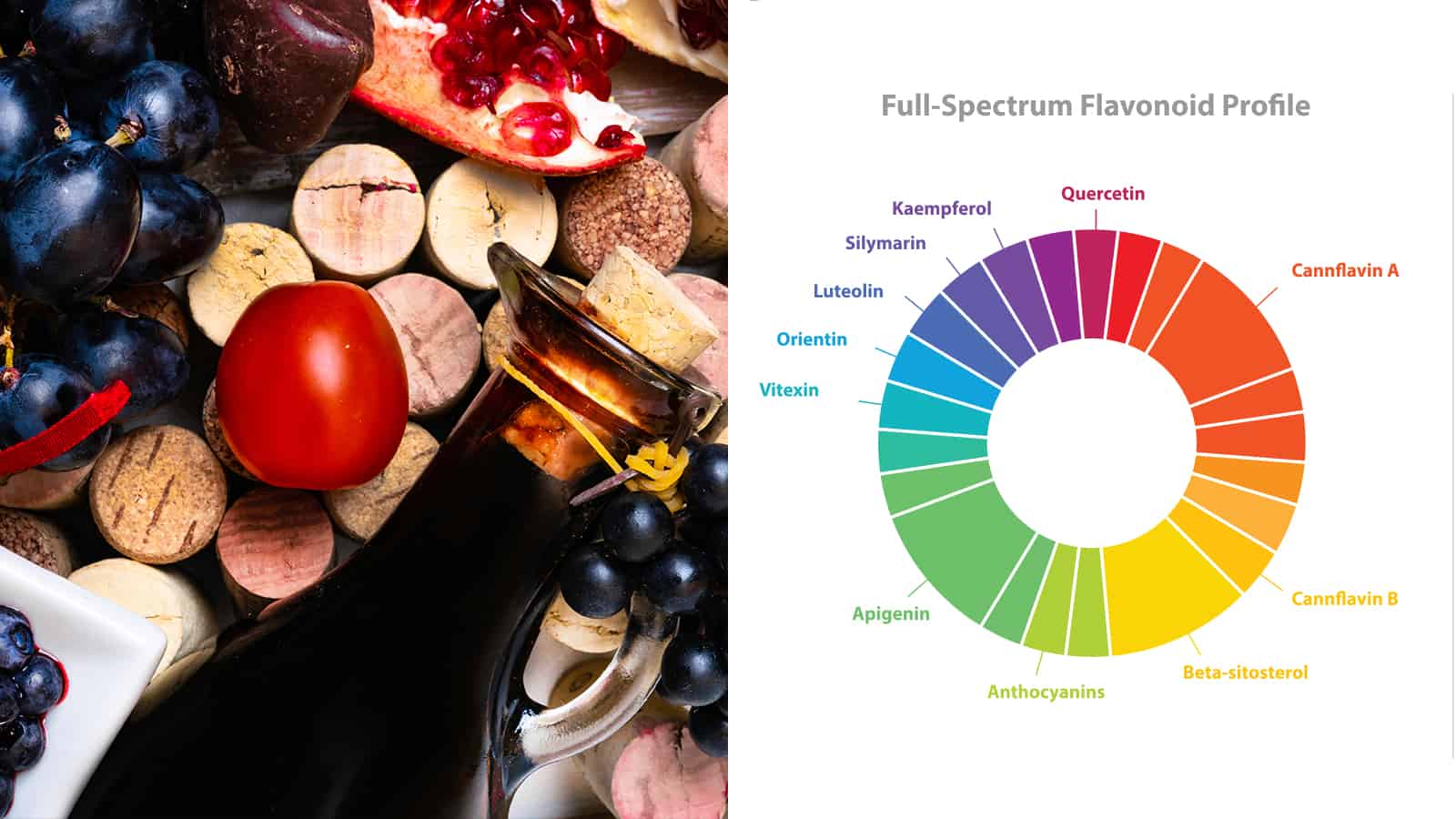Flavonoids refer to specific natural substances that constitute beneficial effects for a person’s mental and physical health. So, if you are looking to be the most intelligent person in your classroom or family or simply looking to be the best version of yourself, flavonoids are just the thing you need inside your body.
The phenolic structures, any compound with a hydroxyl group attached directly to a benzene ring, contain healthful mutagenic, oxidative, carcinogenic, and inflammatory resistant properties. This means that the information around flavonoids and how the body uses them most efficiently is still debated by doctors.
How Flavonoids Increase Brain Health
The original data reflects the immense amount of positive cardiovascular proficiency one can obtain by incorporating the correct number of fruits, vegetables, teas, grains, and other natural products into a balanced diet. The same can be said for its effects on the human brain on how flavonoids can impact cognitive function and mental stability.
In today’s world, the number of processed foods within our society contributed to mental degradation over the past fifty years. So, when you are considering healthy lifestyle choices, you will find that consuming whole foods is one of the only choices you can make to live a happy and fruitful life.
Dr. David Geier, who is a double-board certified orthopedic surgeon and sports medicine specialist, states that eating foods that are high in flavonoids can slow down the decline of brain health as we age. An adult must consume at least 600 milligrams of flavonoids per day, which, in turn, provides them with a 20% lower risk of cognitive decline.
Since damage to the blood vessels (whose primary purpose is to supply the brain with sufficient oxygen) is a crucial factor regarding cognitive decline, eating foods high in flavonoids is essential if you are looking to maintain healthy cognitive function. Flavonoids are a beneficial phytonutrient for optimal heart health.
Flavonoids: The Six Categories
As the research began to expand and become more inclusive regarding the entire body, the benefits of consuming flavonoids regarding brain health have become widely accepted amongst medical professionals. Part of a plant compound group called “phytonutrients,” flavonoids also break down into sub-categories known as:
1. Flavonols
Plants synthesize flavonols as secondary metabolites. While they don’t directly contribute to a plant’s reproductive or developmental capabilities, they tend to assist plants with any environmental stress they may come in contact with. A study purports that flavanols are essential to brain health due to increased blood flow. It is also said to assist with organ performance as well.
2. Flavones
Flavones strictly differ from any other subset of flavonoids due to their molecular structure. That’s because flavones come from plants that produce white (and off-white) colored flowers and wean off insects as well to keep their plant host safe. However, even though scientists and health professionals believe that flavones have an immense impact on cognitive function, it is still unclear exactly how they continue to impact the human body. From what science currently observes, Flavones help lower oxidative stress and pro-inflammatory signaling.
3. Flavan-3-ols
Typically found in cocoa beans and tea, Flavan-3-ols were isolated by Dr. Michiyo Tsujimura in 1929 at the Institute of Physical and Chemical Research in Japan. Some may say that Flavan-3-ols are not essential for human health. Regardless, they still have powerful antioxidant properties any health-loving individual should consider. Its ability to defend your brain against free radicals is still somewhat debated on its overall effectiveness. However, nutritionists know that Flavan-3-ols brings an extra layer of benefits for anyone eating a good number of fruits and vegetables.
4. Flavanones
Flavanones are compounds that affect both a plant’s color and taste. Even though we all cringe at that first bite of grapefruit, flavanones also improve many biological processes within the brain. Forms such as naringin, hesperidin, and eriocitrin are types of flavanones that can be found in anything from lemons to bee pollen, even though the vast majority of flavanones are made with plants themselves.
For example, naringin lowered cholesterol and estrogen in lab animals, while hesperidin worked hand-in-hand with vitamin C to create collagen in joints and skin. Red wine also contains an average number of flavanones. Still, everything in moderation is the key to successful brain function and all bodily functions, for that matter.
5. Anthocyanidins
This sugarless plant pigment is responsible for the pure and vibrant colors of fruits and vegetables. Blueberries, red cabbage, and raspberries are just a few edible plants that typically contain high levels of anthocyanidins. Some examples of anthocyanidins include malvidin, cyanidin, and delphinidin. Each maintains their chemical structures even after being consumed by humans. In contrast, other flavonoids will go through a transformative process after being eaten.
This is what makes anthocyanidins so unique in comparison to the other five flavonoid compounds. Many healthy individuals go out of their way to consume fruit high in anthocyanidins. That’s because the benefits for both brain health and inflammation are abundant in this flavonoid. However, it is crucial to finish the pieces of the plant that contain the color. For example, skinning an eggplant is the wrong move, as all of the Anthocyanidins properties come from within the flesh itself.
6. Isoflavones
Isoflavones are another secondary substance within fruits and vegetables that categorize themselves as a healthy estrogen source. While the estrogenic effects of isoflavones are less potent than the estrogen hormone, it is still a foundational flavonoid that is worth consideration. In combination with phytoestrogens, Isoflavones can help bring balance to low estrogen events such as menopause and reduce the effect of hyper-estrogen within cells.
Once the gut bacteria absorb isoflavones within the intestines, isoflavones can begin their beneficial processes that assist with brain cognition. You can find high levels of isoflavones in foods like soybeans, peanuts, pistachios, and various other fruits and vegetables. Naturally occurring isoflavones are predominately glycosylated. That means they have a tough time absorbing directly into the body. Healthy food processing forms can make isoflavones more bioavailable for human consumption.
According to Baptist Health’s Dr. Scott Davis, flavonoids can positively impact your body, especially your gut flora and GI tract, in a way that good bacteria transform into better bacteria. This is important because positively affecting your gut also assists with lowering your blood pressure. As we all know, high blood pressure can cause heart attacks and strokes, so it’s no wonder that eating a healthy diet full of fruits and vegetables can be the saving grace for your overall brain cognition.
6 Foods to Add Flavonoids to Your Diet
Try a few of these foods–they are excellent sources!
1. Citrus Fruits
Citrus fruits such as lemons, limes, and grapefruit contain flavanones. Simply consuming raw organic versions of citrus fruits will have a fantastic effect on your gut biome, especially when juiced. The bioavailability of these healthy plant compounds will provide your body with the antioxidants needed for proper brain health.
2. Berries
Every berry on planet Earth will contain some form of flavonoids, but not every berry is equal in flavonoid production. The most potent antioxidant berry to date is the blackberry, as they are known to contain all six types of flavonoids within them. A few other great options are raspberries, cherries, and blueberries. Of course, each has a decent amount of anthocyanidins.
3, 4, 5. Onions, Kale, and Red Cabbage
These three vegetables have tremendous effects on brain health due to their nutrient-dense compositions. Of course, onions are a root vegetable. Thus, they pull their nutrient value directly from the earth, making them a powerhouse for vital body functions. They are great for cognitive health and excellent fighters against cancerous cells. Kale is also a great source of flavanols. Indeed, you can add it to other vegetables and fruits to help boost their nutritional value. At the same time, red cabbage could be the lifeblood for anyone looking to mitigate cognitive disorders and diabetes, and cardiovascular disease.
6. Soybeans
While soybeans come in a variety of different options, such as tofu, edamame, tempeh, and soy sauce. Indeed, each of these soybean-derived varieties will give your brain an increase in isoflavones. One word of caution. Be careful about consuming products made with highly concentrated amounts of salt. That’s because the harmful effects of factory production can counteract the health benefits you seek from soybeans.
Final Thoughts On How Flavonoids Increase Brain Health
When adding essential building blocks of healthy brain cognition, you almost cannot find a more beneficial source than the flavonoid family. A balanced diet of fruits and vegetables has been the proverbial lifeforce for as far back as human existence goes, and the opportunity to introduce a high level of dexterity to your brain is an acceptable way to stay sharp and healthy.
While flavonoids are a massive part of a healthy lifestyle, exercising and proper water consumption are crucial as our foods. If we stopped eating processed sugar and processed foods altogether, the clarity and efficiency we need for our best lives would reveal themselves in miraculous ways.
So be sure to get your daily dose of natural and organic fruits and vegetables every day. You will put yourself in the best mental and physical shape that you can. And of course, don’t hesitate to contact your health provider and do your research before switching up your diet, as food sensitivities and allergic reactions can still affect well-being.

















 Community
Community

